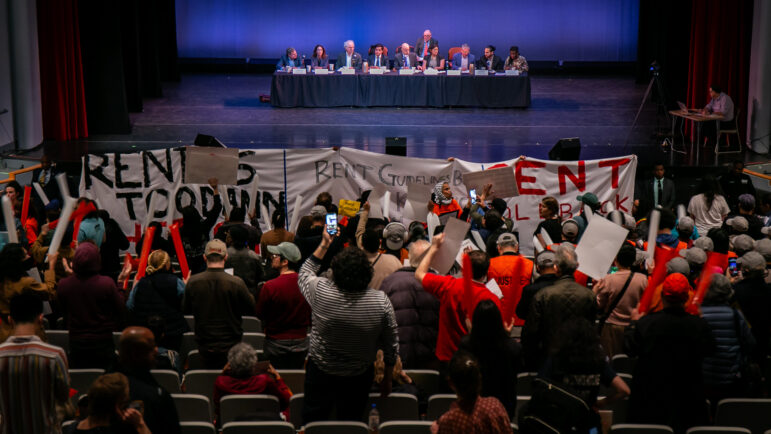
Adi Talwar
CVS's stock price has risen healthily despite its 422:1 executive-to-median pay ratio.
Jerome Murray isn’t asking for much. Working 20 hours a week, he says, would be enough to get his job done and feel a little more comfortable with the money he brings in. “I understand they can’t give me more [than 20],” he says.
Jerome was a 19-year-old student at ASA College in October 2007 when he started in retail. It was a seasonal position at the Ricky’s clothing and makeup store near campus. The season that brought Jerome to Ricky’s ended two months later, and he was laid off. In December 2007, he started working at CVS, where he’s been ever since. Now 26, he works there 12 to 16 hours a week for $9.32 an hour without benefits.
Maria, 62, has been caring for New Yorkers in their homes since 1991. For most of her time in home care, she was a home attendant, also called a personal care aide. She undertook the extra 40 hours of supervision and training to become a home health aide in February of last year. She makes $10 an hour. When she began a quarter-century ago, her hourly wage was $6.25, worth $10.86 today with inflation. On weekends, she’s paid $11.10 – down from $11.25 when she was a home attendant. She doesn’t get overtime.
“For the responsibility of the job we do, we don’t get enough benefits,” Maria tells City Limits. “I do the job because I love the job.”
Maria and Jerome are part of a large and growing contingent of New Yorkers working low-wage jobs with little or no benefits, a group that has expanded significantly even as the New York economy has recovered since the 2007-2008 recession. In the first three years after the recession, all of the state’s income gains went to the top 1 percent of earners, while almost a third of the city’s working population today holds positions with salaries below $45,000.
But persistent low pay in a rebounding economy raises uncomfortable questions: Why have these jobs proliferated? Are global shifts in labor and America’s still-suppressed job market all that drive the trend? Who benefits from underpaid labor?
Executive pay and prerogatives
Since 1991, Maria has been working with Ridgewood Bushwick Senior Citizen Homecare, an arm of the Ridgewood Bushwick Senior Citizens Council (RBSCC). She asked City Limits to use only her first name in this story out of concern about backlash from RBSCC.
A 2010 fraud investigation of RBSCC by the NYC Department of Investigation ultimately led to former Executive Director Christiana Fisher’s 2012 ouster and guilty plea in a federal contempt case. After the fraud investigation, during which government grants to RBSCC were frozen, Maria says her benefits were cut.
James Parrott, chief economist of the Fiscal Policy Institute – a liberal economic think-tank focusing on taxes and labor in New York – says one of the reasons for persistent low wages is that company balance sheets look better when they save on labor costs by cutting salaries and hours. High salaries and bonuses for managers and executives who create short-term profits by cutting labor costs reinforce the behavior.
“To them, it looks like they’re doing the right thing,” Parrott says.
While it plays out differently in the nonprofit and for-profit sectors, this phenomenon is reflected in steep pay gaps between executives and lower-rung employees. When Fisher resigned from RBSCC in 2012, she received severance pay of $206,250. In the 2009 fiscal year, which ended a few weeks before the fraud investigation report was announced, she made $667,063.
Similarly, in a May 2014 study by the research company Payscale, CVS topped the list for gaps between median employee pay and CEO salary at the 100 largest publicly traded companies. The median salary for CVS employees was $28,700 in 2013. That year, CEO Larry Merlo made more than $12 million – giving the firm a 422:1 executive-to-median pay ratio.
Even the traditional institutions of labor power are often unsuccessful at advocating for underpaid workers. Maria, for one, distrusts her union – 1199 SEIU, the massive local that covers health care workers throughout New York and much of the Atlantic coast. When she talks about the relationship between 1199 SEIU and Ridgewood Bushwick, she presses her index fingers tightly together. “They’re pitcher and catcher,” she tells City Limits.
RBSCC was founded by former New York State Assemblyman and Brooklyn Democratic Party Chairman Vito Lopez, who resigned in 2013 after an ethics investigation revealed a pattern of sexual harassment. According to the government transparency organization Sunlight Foundation, Lopez’s top contributor was the Service Employees International Union, the parent union of 1199.
She argues that 1199 negotiates bad deals with RBSCC – the $133/month pension she receives after working more than 20 years, she says, isn’t worth the 2 percent of her base wages she paid in monthly dues to 1199 throughout her time in home-healthcare.
Maria’s health insurance was cut after she went into semi-retirement; under the 1199 contract with Ridgewood Bushwick, home health aides have to work 100 hours per month to be covered. She now pays for health insurance through the Affordable Care Act out of pocket and still works 35-40 hours a month, the maximum that 1199 allows after retirement, just to maintain the $23,000 annual salary she made while working full-time.
Low-cost care=Low wages
The home-healthcare industry has been booming since the turn of the millennium – from 2000 to 2012, total spending on home-healthcare services more than doubled.
From economists to activists, most people attribute the growth of the home-healthcare industry to an aging population of baby boomers in need of affordable care. “home-healthcare is largely a national trend,” Jim Brown, the New York DOL’s labor market analyst for the New York City region, says. “It’s less expensive to provide home-healthcare than to put someone in a [nursing] home.”
“We think home care is the future,” says Janet Kim of Caring Across Generations, a national campaign organizing to improve labor conditions for home care workers.
Brown says Medicaid coverage of home care coupled with the comparatively low cost of the service and a large population retiring in a weak economy have increased the demand for home-healthcare in recent years.
Taxpayers win from this arrangement because Medicare and Medicaid don’t have to subsidize home care as heavily to make it affordable.
From 2000 to 2012, after the federal government implemented a prospective payment system that disburses subsidies to home-healthcare providers in advance for their services, Medicare spending on home health agencies increased from $8.5 billion to $18 billion, and the number of home health agencies grew 64 percent. According to the Medicare Payment Advisory Committee, almost all of the new agencies were for-profit companies, where profit margins averaged 17 percent between 2001 and 2013.
Even with the explosion in government payments, home-healthcare still costs taxpayers less than other health services. According to data from the federal Centers for Medicare and Medicaid Services, total Medicare/Medicaid spending on home-healthcare in 2013 – both from HHAs and direct contracting – was $63.5 billion. Nursing homes and retirement communities cost the government $81.5 billion. Hospitals: $406 billion.
But the low cost of home-healthcare for consumers and taxpayers is linked to even lower wages for home care workers, and the companies that employ home attendants and health aides collect the difference. Cost estimates of long-term care options put the price of daily home-healthcare for clients in New York City at $43,800 a year. Wages of home health workers don’t come close to that number; Kim notes that 92 percent of domestic workers in New York make less than $25,000 a year as the primary income in their household.
As public funding for home care services added profit margin for home health agencies over the last decade, other aspects of public policy fail to protect low-wage workers in the field. The Companionship Exemption to the Fair Labor Standards Act has historically excluded home care providers from overtime and minimum wage laws. The U.S. Department of Labor attempted to narrow the exemption effective January 1, but a legal fight from private HHAs vacated the changes pending appeal.
“The argument is that the job is akin to babysitting,” says Kim.
Ridgewood Bushwick Senior Citizen Homecare, where Maria works, received more than $40 million in revenue from government health care subsidies and client payments in 2012. They spent less than $28 million on non-management salaries and have 1,621 employees – an average salary of about $17,000.
RBSCC contracts George Arzt Communications for public relations. Arzt tells City Limits that Ridgewood Bushwick’s home health aide salaries are “governed by collective bargaining with 1199 [SEIU].” He confirms that health aides make $10 an hour – $11.10 on weekends – without raises or overtime, and that they don’t receive benefits unless they work 100 hours or more per month. But he flatly denies that there were changes to the benefits structure after the 2010 fraud investigation.
When asked to comment on why Ridgewood Bushwick doesn’t pay a living wage to its health aides in spite of the industry’s high profit margins, Arzt claims that the total compensation including benefits is “far above $13.13” – the living-wage standard for New York City set recently by Mayor de Blasio. Arzt tells City Limits that he doesn’t know how many home health aides at the company make the 100-hour-a-month cut-off to receive benefits, but he insists improbably that Ridgewood Bushwick’s average employee hours are exactly 40 per week.
Moments later, he qualifies one unlikely statistic with another. “Any employees working less than that, it’s just because they work someplace else,” Arzt says.
Incentives to cut costs
Another request to add to Jerome’s list: While he regularly works Saturday and Sunday nights, his weekday shifts change and can be scheduled any day of the week. “I’d like a day off,” he says. “Sunday would be nice off.”
Jerome says he used to work more hours at CVS, but his shifts got cut when the company’s profits fell after the chain stopped selling tobacco products last September. “I ask my manager for more hours, but they tell me they don’t have it,” he says. “They took a big hit in their profits, and now we’re suffering,” he says.
When asked about the benefits of a part-time labor force with changeable schedules, one store manager at a clothing outlet in Brooklyn, who spoke with City Limits on the condition that we not use his name or the name of his company – “the company doesn’t want its name associated with a story like this,” he said in our interview – says that the company he works for needs a largely part-time workforce in order to be profitable. The company gives managers access to the profit numbers and budget breakdowns of their and others’ stores; “if I raise everyone to full-time,” the manager says, “we would lose money.”
That argument is connected to the principle that the sole mission of companies is to maximize profits for their shareholders – a widely-held tenet that harkens back to the increase in hostile corporate takeovers in the 1980s. The growing possibility of takeovers facilitated by expanding equity markets forced corporate managers to prioritize returns for company stockholders to keep them from selling to hostile buyers.
CVS has proven adept at maximizing profits since the recession. Their stock yield has more than doubled the benchmark S&P 500 index over the last five years and nearly doubled the returns of Walgreens, their primary competitor and the largest pharmacy retail chain in the country. Since CVS stopped selling tobacco products in Fall 2014 – a move they claimed would cost $2 billion in annual revenue and which Jerome says led to the cut in his hours – the company’s share value has grown more than 25 percent.
CVS shares have been good value for investors – including New York City’s pension fund, which holds more than $70 million of CVS stock. Annual dividends per share have increased from about 15¢ in 2005 to $1.10 in 2014.
Along with dividends and investment payoffs, the revenue that companies bring in becomes political leverage to ensure continued profits. CVS spent almost $14 million on lobbying efforts in 2013 alone, much of it fighting restrictions on how the company can use the prescription drug plans managed by their subsidiary Caremark to steer customers to CVS pharmacies. CVS has also given millions in direct contributions to political campaigns and Political Action Committees – including $100,000 to a PAC called Coalition to Save Florida Jobs, formed in 2004 for the sole purpose of opposing a ballot initiative that successfully increased the state’s minimum wage to $6.15 the following year.
Do consumers benefit?
The actual benefit for companies of cutting wages and part-timing labor is unclear. Adam Cobb, an assistant professor at the University of Pennsylvania’s Wharton School of Business, notes that companies often mistakenly equate labor rates with labor costs when calculating how much they save. The former is simply a worker’s wage, but the latter accounts for productivity, which is lower per dollar of wage for part-time workers than full-time, because full-time employees feel more dedicated to their companies and provide better customer service.
“The reality is, if you pay people more, they tend to work harder,” Cobb says.
“Employers don’t always see it that way,” Parrott tells City Limits. “They just see the first iteration [of bottom-line costs]…. They’re operating with very limited information.”
Still, the prevailing thinking among most retail businesses remains as the clothing store manager described it: Low wages correspond to low costs and high profits. Elise Gould, an economist who researches wages and labor markets for the progressive Economic Policy Institute in Washington, D.C., says she thinks the lingering insistence on lowering wages is a cultural phenomenon in the business community related to the decline in workers’ collective bargaining power in recent decades.
CostCo and Trader Joe’s have long been held as examples of a successful retail business model that uses high wages and benefits to encourage employee loyalty, satisfaction, and productivity. Gould says she doesn’t know why more businesses don’t adopt the CostCo method. “I think we’ve changed the employer/employee relationship in the last 30 years,” says Gould, and now many employers have difficulty shifting their view to see the benefits of paying a higher wage.
“There’s some inertia,” she says.
Meanwhile, just as taxpayers benefit from reduced government subsidies to low-wage fields like home-healthcare, consumers reap some of the rewards when workers lose out in private industry. Persistent low inflation has been a bargain for shoppers, but it’s also left businesses little room to raise prices to pay for wage increases.
Indeed, a common argument for keeping wages low is that increased labor expenses will pass on to consumers as higher product costs. Research is all over the map. An oft-cited (but largely discredited) study from the University of Kansas purported to show that increasing the starting wage for McDonald’s employees to $15/hour would only raise the cost of a Big Mac by 68¢. Subsequent studies of McDonald’s wage increases have shown various Big Mac cost hikes, from 5¢ to 25¢ for a $10.50 wage to $1.28 for a $15 wage. In the hard-fought politics of bottom-tier wages, though, caveats always seem to apply: The $1.28 estimate comes from a study by the Employment Policies Institute, a conservative research organization run by former restaurant, beverage, and retail industry lobbyist Richard Berman.
Instead of raising prices, retailers might use cheaper materials or sell a lower-quality product. Reducing quality often has wage and labor impacts too; many clothing manufacturers and other retailers are turning to overseas production to cut labor rates in their supply chain. The federal Bureau of Labor Statistics projects apparel knitting as the U.S. industry that will shrink most by 2020, dropping to 66,100 workers from more than 150,000 in 2010.
But research suggests that price increases because of higher wages would be minimal relative to the broad economic gains that would accompany wage growth. One 2012 study by the University of California, Berkeley’s Labor Center looking at legislation proposed by former Rep. George Miller (D-CA) and former Sen. Tom Harkin (D-IA) to raise the federal minimum wage to $9.80 found that restaurant prices would rise less than one percent and grocery store food prices would increase less than half of one percent if the law were enacted. In the meantime, the wage increase would boost the income of 20 million workers, increasing pay more than 33 percent for untipped minimum wage earners. According to the Economic Policy Institute, the Miller/Harkin wage hike would have also increased GDP by $25 billion and added 100,000 new jobs.
Gould notes that increases to the lowest wages also cause wage growth for those with slightly higher salaries because of adjustments to keep hierarchies intact – supervisors still make more than people they supervise, however high the supervisees’ wages rise. She argues that the overall economic stimulus of low wages rising has a cumulative effect that reverberates up the income ladder. “If incomes had grown more equally from 1979 to 2007, the median family would have almost $18,000 more,” she says. “[Wage stagnation] means most people have less money in their pocket.”
“It’s in no one’s interest” to keep low wages from rising, Parrott says. “Rich people would be richer if we had less income inequality.”
“A job is a job”
Parrott notes that in the current recovery, increases to the minimum wage have been associated with higher employment levels, suggesting that rising wages haven’t caused problems for companies’ bottom lines.
Gov. Cuomo recently announced a plan to increase New York City’s minimum wage to $11.50 by the end of 2016, moving Albany part of the way toward de Blasio’s proposal to raise the city’s minimum wage to $13.13. Ed Cox, New York State’s Republican Party chairman, said of Cuomo’s proposal: “Raise the minimum wage and you reduce opportunities for people on the lower end of the economic ladder to get their first job.”
The Fiscal Policy Institute publishes yearly analyses of employment growth by wage level. According to their latest analysis – which covers data through January 2015 and was released early to City Limits for this story – high- and medium-wage industries in New York City have grown by 5.3 percent and 2.3 percent respectively since the pre-recession peak. Low-wage industries have grown 24.2 percent.
Meanwhile, hundreds of thousands of New Yorkers are living paycheck to paycheck in low-wage jobs. Some wonder, like Jerome, if they’ll ever be able to pay off their student debt, or like Maria if they’ll ever be able to stop working.
“A job is a job,” Jerome says. The retail industry ain’t bad,” he adds, “if you get better hours and better pay.”
Reporting for this story was generously supported by the Puffin Foundation.









One thought on “Who Profits from Low Wages?”
Its true. A job is job, if one gets betters hours and the better pay. Why low pages, might be some issues. But these issues can’t be ignore also. So there should be proper description for the agreements or the laws for the employees and for the employers too. For the complete detail, go through http://www.legisocial.fr once.